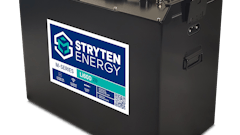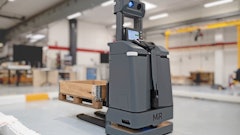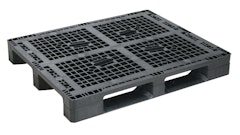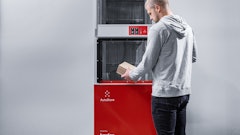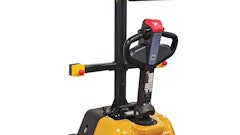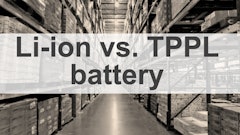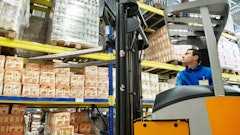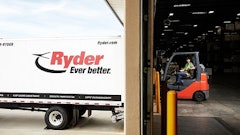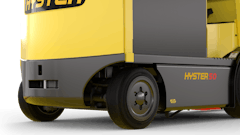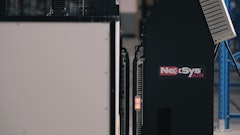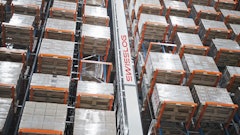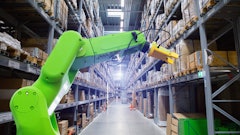While it seems quite simple in theory, in application, it's not. To successfully navigate into a vertical facility, companies will have to move materials between levels in an orchestrated fashion that does not create bottlenecks. To do that, vertical reciprocating conveyors (VRCs) are among the fastest and easiest to install, maintain and operate, say many in the material handling field.
VRCs, which are made to move products from one level to another, can operate as stand-alone units or be incorporated into an automated system. Models are available to handle any product, from single items to full pallet loads. Different models are available to handle loads from 10 pounds to 100,000 pounds or more.
Many Configurations Are Available Much like elevators for people, VRCs are platforms or cages moving up and down on steel rails or guideways. There are many configurations of VRCs, including those with a single mast, single rail, double mast, double rail, straddle or cantilever. There are also numerous platform configurations, ranging from a simple flat steel surface to a powered roller conveyor deck that is integrated with the controls of powered feed and take-away conveyor lines at the different levels.
They can function in manufacturing or warehousing operations; applications range from simple two-level facilities to more sophisticated, multi-leveled, multi-directional systems.
"I've seen some of these installations, and they really impressed me," says Ken Ackerman, president of K.B. Ackerman Co., a material handling consultancy based in Columbus, OH. "In retail especially, we're seeing a lot of picking modules on three or four levels in really high buildings, all feeding into multiple conveyors."
These conveyors, which have seen a lot of use in heavily automated manufacturing facilities, are making inroads into distribution operations as well, observes Tim McGill, president of Interroll's Dynamic Storage Products Division in Newmarket, Ontario, Canada. He has noticed a lot more of these systems in use, especially by big-box retailers like Wal-Mart, but is also seeing them among smaller retailers like Publix Super Markets and Wal-greens.
The reason, says Chris Doyle, director of marketing at material handling systems integrator Cisco-Eagle, based in Dallas, is that "mechanical vertical reciprocating conveyors offer versatility and dependability for high-speed and multi-level applications and for moving large, heavy loads. Mechanical VRCs offer durable, heavy-duty construction and maximum flexibility in carriage size, capacity and traffic patterns."
And, in terms of space, VRCs require a lot less of it than many other options for moving product between levels. The average VRC has a footprint of about 3-feet-by-4-feet, but units can be as big as 30-feet-by-30-feet.
VRCs "elevate or lower products with a very small footprint. You can do it with a spiral conveyor or other units, but they take up much more floor space," says Cary Lindauer, senior engineer at Nercon Engineering and Manufacturing, Osh Kosh, WI, manufacturer of the FlexLift VRC. "Space is sometimes a lot of the issue. Is it the main reason for buying them? No, but it quickly becomes a big benefit."
But, Lindauer adds, "the cost and efficiency of [a VRC] is even more crucial than the footprint."
Typically, a basic VRC to move a single case or carton at a time between floors will cost about $6,000 to $11,000. Those that move full pallets can be considerably more expensive, depending on size, weight capacity, distance traveled, etc., according to Cisco-Eagle's Doyle.
Costs Vary Among Systems Perhaps the cheapest conveyor system for taking product up or down a level is an incline conveyor, which sells for an average of about $2,500, but takes up considerably more space, Cisco-Eagle's Doyle adds.
The costs of a VRC are considerably less than those associated with full freight elevators, long the industry standard for moving product between levels. VRCs cost, on average, about one-tenth less.
And because VRCs can be integrated into other conveyors so that products roll on and off them automatically, an operator only has to hit a button to turn on the machine and can then walk away, says Ackerman.
"From a cost standpoint, you also save on personnel with VRCs because you do not need someone to remove products from an elevator and load them onto a conveyor," adds Nercon's Lindauer.
In terms of throughput, the average VRC will give you three to five cycles a minute, Doyle notes. That is far less than with an incline conveyor, "which can get you 20-30 products on the discharge end in a minute, but they have a much greater distance to travel," he adds.
Another option, especially for moving pallets on and off a mezzanine, has been forklifts. While that may be the simplest way, using forklifts ties up people and equipment that could better be used elsewhere.
That is not to say that there is only one type of conveyor that will help you take products to another level. "If you go up, there are a handful of elevation-changing equipment options you can use," says Doyle, who notes that companies can also use vertical continuous conveyors, inclines or declines, spiral conveyors, belt conveyors or merge conveyors to do the same job.
Which one you use, he continues, "depends on environmental concerns, costs, what's taking place in the DC and what's taking place upstream or downstream. In most cases, we see multiple methodologies in place to move products. You ultimately want to do something where it will not create bottlenecks.



